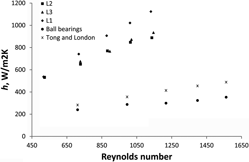Crossref Citations
This article has been cited by the following publications. This list is generated based on data provided by
Crossref.
Liu, P.S.
and
Cui, G.
2015.
Characterization of the electromagnetic shielding and compressive behavior of a highly porous titanium foam with spherical pores.
Journal of Materials Research,
Vol. 30,
Issue. 22,
p.
3510.
Dixit, Tisha
and
Ghosh, Indranil
2016.
An experimental study on open cell metal foam as extended heat transfer surface.
Experimental Thermal and Fluid Science,
Vol. 77,
Issue. ,
p.
28.
Tisha, Dixit
and
Indranil, Ghosh
2017.
Prospective of employing high porosity open-cell metal foams in passive cryogenic radiators for space applications.
IOP Conference Series: Materials Science and Engineering,
Vol. 171,
Issue. ,
p.
012048.
Dixit, Tisha
and
Ghosh, Indranil
2018.
Simulation intricacies of open-cell metal foam fin subjected to convective flow.
Applied Thermal Engineering,
Vol. 137,
Issue. ,
p.
532.
Chen, B.
Liu, Peisheng
and
Chen, J.H.
2018.
Influence of processing on surface morphology and specific surface area for the nickel foam made by electrodeposition.
Multidiscipline Modeling in Materials and Structures,
Vol. 14,
Issue. 4,
p.
735.
Wang, Congzhen
Gan, Xueping
Tao, Jingmei
Xie, Ming
Yi, Jianhong
and
Liu, Yichun
2019.
Compression and electromagnetic shielding properties of CNTs reinforced copper foams prepared through electrodeposition.
Vacuum,
Vol. 167,
Issue. ,
p.
159.
Feng, Zhicheng
Yang, Wenbin
Liu, Xu
He, Fangfang
Li, Yongsheng
Zhou, Yuanlin
Fan, Jinghui
and
Zhang, Kai
2020.
Experimental and numerical investigation of phase change progress for paraffin in hybrid aerogel of graphene and carbon nanotubes.
Applied Thermal Engineering,
Vol. 178,
Issue. ,
p.
115633.
Liu, P.S.
and
Ma, X.M.
2020.
Property relations based on the octahedral structure model with body-centered cubic mode for porous metal foams.
Materials & Design,
Vol. 188,
Issue. ,
p.
108413.
Usman, Muhammad
Pan, Lujun
Farid, Amjad
Khan, Abdul Sammed
Yongpeng, Zhao
Khan, M. Aslam
and
Hashim, Muhammad
2020.
Carbon nanocoils-nickel foam decorated with silver nanoparticles/sheets using a novel stirring assisted electrodeposition technique for non-enzymatic glucose sensor.
Carbon,
Vol. 157,
Issue. ,
p.
761.
Aksenov, B
Rydalina, N
and
Antonova, E
2020.
Porous Materials in Heat Exchangers Used in Heating.
IOP Conference Series: Earth and Environmental Science,
Vol. 459,
Issue. 6,
p.
062079.
Vazifeshenas, Y.
Sedighi, K.
and
Shakeri, M.
2020.
Open Cell Metal Foam as Extended Coolant Surface – Fuel Cell Application.
Fuel Cells,
Vol. 20,
Issue. 2,
p.
108.
Wan, Tan
Liu, Yuan
Zhou, Canxu
Chen, Xiang
and
Li, Yanxiang
2021.
Fabrication, properties, and applications of open-cell aluminum foams: A review.
Journal of Materials Science & Technology,
Vol. 62,
Issue. ,
p.
11.
Slimani, L.
Hamadouche, A.
Bousri, A.
and
Ben Hamed, H.
2022.
Heat transfer enhancement using 40 kHz ultrasound and metal foams inside a horizontal mini-channel.
Applied Thermal Engineering,
Vol. 216,
Issue. ,
p.
119039.
Ataeiyan, Behnam
Kouravand, Shahriar
and
Chegini, Gholamreza
2023.
Robust design of a novel regenerative heat exchanger with high porosity ceramic matrix to waste heat recovery of flue gas.
Experimental Heat Transfer,
Vol. 36,
Issue. 1,
p.
26.
Patel, Nikunj
Mittal, Gaurav
Agrawal, Mitushi
and
Pradhan, Ajaya Kumar
2024.
Aluminum foam production, properties, and applications: a review.
International Journal of Metalcasting,
Vol. 18,
Issue. 3,
p.
2181.
Anderson, Ryan
Skuntz, Matthew E.
Thornton, Isaak
Wilking, James N.
and
Seymour, Joseph D.
2024.
Heat transfer visualization by MRI using 3D printed phase change materials
.
p.
637.
Yao, Lin
Li, Luqiang
Jiang, Hongqu
Luo, Yuan
Wu, Haijun
Zhao, Qi
Yang, Xingxia
and
Liu, Yichun
2025.
A study of the electromagnetic shielding properties of epoxy resin matrix composites synergistically reinforced with CNTs and Copper foams.
Journal of Materials Research and Technology,
Vol. 36,
Issue. ,
p.
3058.


